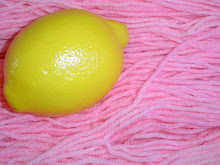A Little More Juno
I've almost finished the back of Juno. I'm at the point now where I'll start the shoulder and back neck shaping. I always think it's funny to look at ribbed pieces of knitting - they look so long and skinny because the ribbing pulls them in. As I was measuring for the length, I spread the piece out to what the width will be when I block it because when you open up ribbing, it will shorten a bit lengthwise. Just something to keep in mind for this or any other garment with lots of ribbing on it.
There was a comment the other day from someone who loved the Juno design but it wasn't written in her size and she wasn't sure she wanted to commit to making adjustments. I honestly think this would be an easy design to change sizes on. If you look at the sweater, it's basically a 2 x 2 ribbed cardigan with a V neck and set in sleeves. It's meant to fit with very little ease. (I'm making the size for a person with a 34 inch bust and the finished garment is only supposed to have 1-1/2 inches of positive ease at that size.) The thing that makes Juno interesting is the cabled collar - and if you look at the pattern, you see that it's just knit to fit the neckline (there are surprisingly few directions for the collar). My theory is that you could find a yarn that gets you the same gauge as the pattern (4 stitches per inch) and use it in any generic V neck cardi pattern. The Knitter's Handy Book Of Sweater Patterns would be a great place to start. You might have to tweak the numbers a bit for your ribbing (a 2 x 2 rib is a 4 stitch repeat + 2), but you could knit it in a size pretty close to your actual measurements (I would think that you could go up to 3 inches of positive ease if that makes you feel more comfortable than 1-1/2, because the ribs are going to draw in some too). Then use the Juno pattern for the collar and knit it to fit your own sweater.
Thanks for all the complements on my vest yesterday! There was a question about the size. The only size I know about is the one I knit and according to the pattern this size will fit up to a 38 inch bust. Since the fronts overlap, you just adjust the overlap more or less depending on your front porch situation (in the Department of Too Much Information, my own front porch is 33 inches, so this gives me plenty of room). If you need a larger size AND you want to add 10 stitches to the cast on, you might contact Colorsong and see if you can just buy 2 skeins of the Fleece Artist Scotia Silk and buy the pattern by itself instead of in a kit. This way you could add to your length and knit the pieces of the vest to your own personal measurements. The pattern is written to work from 2 balls of yarn at once (the kit has two half weight skeins in it for you to work from). I would definitely do a gauge swatch and measure it before and after washing - this yarn relaxes and changes after washing.
Labels: Juno











1 Comments:
I think you are probably right about Colorsong helping someone work out a kit to fit them. In my experience, they have been very helpful. Although Juno isn't for me, I appreciate the way you helpfully deconstructed it for someone not sure how to make adjustments.
Post a Comment
<< Home